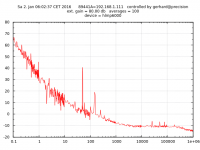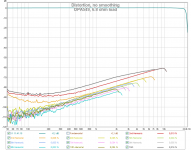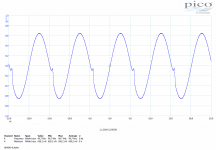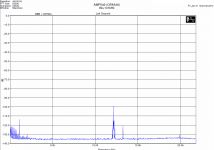Are you aware of this?
https://www.faa.gov/uas/registration/
Yes, all the toy drones weigh much less than 250 gm. The ones I gave away weigh 34 gms.
Happy New Year Richard. Are you ever going to try those speakers we traded for?
I am so multi-tasking these days I'll never get to them. I can ship them to you.
Now I travel more and that leaves less time here to do projects. between house upkeep/repair and other ideas to try out, I cant do anything which takes a long time... I have no ability to do wood work, either.
Thx- Richard
Richard I still have the B&K mic section we traded for in the box, never used that either and needed to find all the other pieces to make it work like the power supply and the capsule. I also still have the cabinets. But I could use those speakers for testing myself. I'm determined to get the speakers produced this year with the molded enclosures.
- to sound quality, in terms of fineness of texture.to sound quality or available wiggle room in processing?
Wiggle room is the main advantage of longer word lengths, like 24 and 32 bit. Recording at 24 bit enables much lower record levels, for example -12dBfs peaks are my norm while tracking. When I had to record in 16 bit, I tried to get the peaks to hit -1dB which, as you can imagine, was hazardous.
In terms of sound quality, engineers whom I respect (those who care about such things) would rather record at 16/176 or 16/192 than 24/44, if they had to choose. These days you seldom have to choose!
George, this isn't the most mathematically precise explanation. I've posted some nice papers without (IMHO) overly difficult math. I guess no one pays any attention. Missed above, yes JC harbors the totally incorrect misconceptions that linger, I guess will linger, ad nauseum.
Continue to teach me everybody! '-)
As it is a custom to have large family meetings these days, there is a lot of food/wine/sweets consumption, to the point of –as a friend said-"I can’t walk anymore, I can only roll around".
So this evening, unable to do something useful, I sat in front of the pc screen doing a long back search on this forum for the subject ‘dither’.
While the previous years the subject was discussed once or twice per year, 2015 was it’s year. Strong bursts appearing Dec 2014, Feb, Mar, Apr, Dec 2015.
Despite of links, data, FFT plots, explanation accumulation over time, individuals reaction pattern remains unaltered, like during the first time. People don’t change.
Any chance that this year things will be different?
No. Nevertheless.
https://youtu.be/IRlohQw-1DY
George
Richard I still have the B&K mic section we traded for in the box, never used that either and needed to find all the other pieces to make it work like the power supply and the capsule. I also still have the cabinets. But I could use those speakers for testing myself. I'm determined to get the speakers produced this year with the molded enclosures.
keep it. I have several measurement grade microphones here. I'll look for your speakers. If you the time to test them and use them, that would be great.
-RNM
The OPPO listening went well. Only complaint which stands out is the bass and deep bass where things are not as accurate sounding to live. The ML-9600 is easily better down there. Othewise, it is very clean and sharp and detailed on the CD I tried. Copies of CD made on my Sony All-in-One desk top computer... sounds pretty sad in comparison. I may make copies in future with the ML-9600 instead.
The OPPO 105D has way too many features for me to try or even be interested in.... but one is the USB... listening to files on the USB will let me compare to listening to the same on the Auraliti PK-100. The files are all HD downloads mixed down to 24/96.
THx-RNMarsh
The OPPO 105D has way too many features for me to try or even be interested in.... but one is the USB... listening to files on the USB will let me compare to listening to the same on the Auraliti PK-100. The files are all HD downloads mixed down to 24/96.
THx-RNMarsh
Last edited:
Thanks Richard. I wanted to move up to a B&K mic from my Earthworks so I could measure above 20Khz accurately but haven't gotten the 1/4" B&K capsule that requires. If you find those speakers that would save me building up another pair from parts.
Hope your new years day is going well.
Hope your new years day is going well.
Kindhornman, you can try adapting Microtech Gefell MK301 1/4" capsule to your B&K mic. If I'm not mistaken, they have the same mounting threads.
Pre 1992 capsules (East German at that time) pop-up regulary at very decent prices. Capsules from actual production cost about the same as B&K. PM me for links, if needed.
Pre 1992 capsules (East German at that time) pop-up regulary at very decent prices. Capsules from actual production cost about the same as B&K. PM me for links, if needed.
Electroj,
Thanks for the information I didn't know that. Do those mics have a nickel diaphragm like the B&K does? I see B&K mics on Ebay once in awhile but they are never cheap that is for sure. I've seen the power supplies in many electronic surplus stores for okay prices but you never know what condition they are in, if even operational. I would assume that they would perhaps need new capacitors to get them back working at the minimum.
Thanks for the information I didn't know that. Do those mics have a nickel diaphragm like the B&K does? I see B&K mics on Ebay once in awhile but they are never cheap that is for sure. I've seen the power supplies in many electronic surplus stores for okay prices but you never know what condition they are in, if even operational. I would assume that they would perhaps need new capacitors to get them back working at the minimum.
Yes. Polarizing voltage = 200V. Gefell measurement mics were the "B&K of the Eastern block"Do those mics have a nickel diaphragm like the B&K does?
Last edited:
to sound quality or available wiggle room in processing?
For recording, neither. But the bigger numbers impress a tiny minority of consumers. The vast majority don't care which explains the failure of high bitrates whether SACD, DVD-A or downloads, to go mainstream.
Higher sample rates can be helpful for music synthcesis by reducing the audible impact of aliasing due to nonlinear processing.
For recording, neither. But the bigger numbers impress a tiny minority of consumers.
More to it than that.
Interestingly, the quietest red LEDs I've found were the HLMP6000, which are pretty tiny. Lowest impedances as well, so there may be a relationship.
I've got some HLMP6000s in the meantime; order at digi-key in Thief River Falls to
delivery on the doorstep in a small town in Germany < 36 hours including customs:
pretty good performance.
of the xmas parcel deluge.
Nevertheless, this is the noise performance (and methinks they are quite dim at 12 mA):
0 dB = 1nV/sqrt Hz. I like them.
Attachments
Last edited:
I think it is a forgone conclusion that with worse amp THD above 20KHz will do poorly inband in the presence of HF/RF. And, like the HF from an unfiltered HF DAC the frequencies are many and wide band... there would be many more IM products produced than a two tone test at HF.
I just culled some typical well known amp performance from Stereophile that people buy which fits the bill for higher audio distortion with HF.
View attachment 522049
I hope this one will meet your criteria for a sufficiently bad amplifier
Please note THD rising with frequency and also the distortion composed of high order harmonics - one of the best examples of cross-over distortion ever.
This is nicely seen at the 100kHz signal plot.
The intermodulations are worst when signal frequency is about 100kHz, when input RC filter is yet not effective. With my usual HF test 900+910kHz, this amp has no problems. But it has problems with intermodulations in the 19+20kHz test and here 89+101kHz is shown.
But I would say that most of problems of this amp lie in audio band, ultrasonic intermodulation is just a cherry on a cake.
Just maybe, its sound could attract some of the reviewers
Attachments
Gerhard, have you measure anything from Osram, such as LA-L296 or similar ?
Patrick
Message #73341 from 2015-09-27 or so in this thread.
< http://www.diyaudio.com/forums/lounge/146693-john-curls-blowtorch-preamplifier-part-ii-7335.html >
More noise, but much more light
and oct-27
< http://www.diyaudio.com/forums/lounge/146693-john-curls-blowtorch-preamplifier-part-ii-7522.html >
Last edited:
Whilst this product is firmly in the 'high end' the measurements are worth looking at in context of the ongoing disucssions Balanced Audio Technology Rex II line preamplifier Measurements | Stereophile.com
In this case the pre-amp has slightly less than stellar results from the 19-20KHz test. Ok its a very very unlikely scenario with any real music, but an interesting data point.
In this case the pre-amp has slightly less than stellar results from the 19-20KHz test. Ok its a very very unlikely scenario with any real music, but an interesting data point.
Message #73341 from 2015-09-27 or so in this thread.
< http://www.diyaudio.com/forums/lounge/146693-john-curls-blowtorch-preamplifier-part-ii-7335.html >
More noise, but much more light
and oct-27
< http://www.diyaudio.com/forums/lounge/146693-john-curls-blowtorch-preamplifier-part-ii-7522.html >
If you get the time why don't you try overdriving an LED a bit until the light output drops and then recheck the noise level? I suspect there is a correlation between brightness and noise as you mention. Certainly between output and photo electric noise pick up.
- Status
- Not open for further replies.
- Home
- Member Areas
- The Lounge
- John Curl's Blowtorch preamplifier part II



